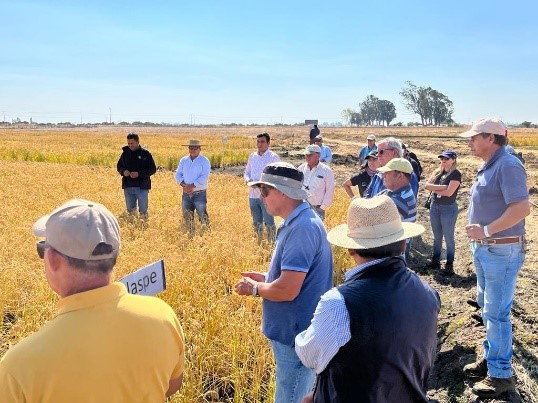|
Did you know that:
|
 I recently traveled to Parral and San Carlos in the Ñuble and Maule regions of Chile, where the country’s rice is produced. We had the opportunity to visit several of the projects that the Inter-American Institute for Cooperation on Agriculture (IICA) has been working on with the Instituto de Investigaciones Agropecuarias (INIA) to enhance the sustainability of rice production since 2017.
I recently traveled to Parral and San Carlos in the Ñuble and Maule regions of Chile, where the country’s rice is produced. We had the opportunity to visit several of the projects that the Inter-American Institute for Cooperation on Agriculture (IICA) has been working on with the Instituto de Investigaciones Agropecuarias (INIA) to enhance the sustainability of rice production since 2017.
Over 200 farmers, technicians, researchers and other stakeholders of the rice value chain participated in the field days held. The combination of perspectives and priorities led to rich discussions, as the different research efforts were presented and observed in the field.
A third of irrigation water globally goes to rice production, and Chile´s rice is even more water intensive (23,000 m3/ha), given that it is used, as elsewhere, to control weeds, but also in this case as a thermal buffer given the colder temperatures in the growing region. Rice is grown in only one cycle per year, with planting usually occurring in November, and harvesting in March.
Producers mentioned that for 15 years, now, they have not had the water they need to produce and that the climate is changing. They know that the amount of water they had in the past will never come back. Many of those present acknowledged that they have reduced their acreage as a result, and also have neighbors that have dropped producing rice all together, switching to other easier to grow, more profitable crops.
 At the same time, the farmers face tight margins, limited market options, high input costs, and heavy weed pressure. One advantage is that there are no pests in the country, thus no need for pesticides. Productivity varies, but averages about 6.5 tons per hectare, lower than in neighboring regions. Many expressed concern for how to produce in a way that is economically viable and more sustainable, and an interest in learning about ways they can potentially adjust their practices.
At the same time, the farmers face tight margins, limited market options, high input costs, and heavy weed pressure. One advantage is that there are no pests in the country, thus no need for pesticides. Productivity varies, but averages about 6.5 tons per hectare, lower than in neighboring regions. Many expressed concern for how to produce in a way that is economically viable and more sustainable, and an interest in learning about ways they can potentially adjust their practices.
INIA has been working on genetic improvement to give growers a leg up in that direction, and it´s expected a few new varieties will be available for the 2024 growing season that are shorter, maintain yields and mature more quickly. Partners have been working to validate and adapt the System of Rice Intensification, or SRI, over seven growing seasons. These projects are financed by the regional governments, the Foundation for Agricultural Innovation (FIA), and FONTAGRO, which is a sustainable co-financing mechanism for the development of agricultural technology in Latin America and the Caribbean.
The System of Rice Intensification is an agroecological method of producing rice that changes the management of the plant, water, soil and other inputs based on four principles that can be implemented through a wide range of practices according to the context. The principles are to:
- reduce competition among plants,
- early and healthy plant establishment,
- improve soil management to favor healthy, aerated soils with higher organic matter and micro-organisms,
- change water management and avoid flooded conditions.
|
“Rice production is responsible for approximately 10% of all emissions from the agriculture sector, and also for around 10% of global methane emissions.” |
 When implemented, these principles produce a powerful set of economic, agronomic and environmental benefits. It was originally thought that the system would not work in Chile, but at both the experimental and commercial level, this has proven untrue.
When implemented, these principles produce a powerful set of economic, agronomic and environmental benefits. It was originally thought that the system would not work in Chile, but at both the experimental and commercial level, this has proven untrue.
SRI also has the benefit of reducing the methane emissions from rice cultivation. Rice production is responsible for approximately 10% of all emissions from the agriculture sector, and also for around 10% of global methane emissions. As methane is a gas that lasts only 12 years in the atmosphere, reducing methane emissions can help buy us time to make some of the other systemic changes society needs to better mitigate – principally phasing out our dependence on fossil fuels.
|
“Farmers have achieved similar yields to conventional methods using half the seed, less herbicides, and perhaps most importantly for them, half the water and lower costs.” |
Farmers have achieved similar yields to conventional methods using half the seed, less herbicides, and perhaps most importantly for them, half the water and lower costs. This has been possible through the adoption of various practices, including planting at 30 cm intervals between lines using a direct seeder, irrigating rather than flooding the rice, and letting the soils dry out in between irrigations, and using mechanical weed control.
Six participatory innovation groups bring 10-20 farmers together in different communities, where a leader in each group has planted one hectare with SRI principles. Once a month, the farmers come together to observe practices and evaluate the development of the crops and debate about challenges and potential solutions. These discussions involve researchers and extension agents and others with interest in scaling these innovations.
|
“We are currently testing surface and sub-surface drip irrigation in SRI at various intervals to reduce water usage and achieve a target of less than 10,000 liters per hectare.” |
 The drought is a powerful driver towards innovation, and much more needs to be done to keep improving. At INIA´s experimental station in San Carlos, we are now testing surface and sub-surface drip irrigation in SRI at different intervals to reduce water use even further and drive it below 10,000 liters per hectare. We want to measure methane reduction in the commercial scale parcels. The mechanical weeder tested requires optimization, and more needs to be done to adjust herbicide use and other field conditions, for example leveling for irrigation rather than flooding, and eliminating the bunds which should no longer be necessary.
The drought is a powerful driver towards innovation, and much more needs to be done to keep improving. At INIA´s experimental station in San Carlos, we are now testing surface and sub-surface drip irrigation in SRI at different intervals to reduce water use even further and drive it below 10,000 liters per hectare. We want to measure methane reduction in the commercial scale parcels. The mechanical weeder tested requires optimization, and more needs to be done to adjust herbicide use and other field conditions, for example leveling for irrigation rather than flooding, and eliminating the bunds which should no longer be necessary.
The practice of crop rotation - leaving the field fallow, planting a different crop, or allowing animals to graze in the gap year will greatly help to reduce, though not eliminate weed pressure. High herbicide use and changing weed patters have led INIA´s weed specialist to believe that there is growing resistance to the chemicals used in the area.
Merely focusing on the agronomic technology level is insufficient to solve the problem. We need to address the broader system to bring about a sustainable change. Farmers require support to reduce the risk of changing the practices they have used for decades. Both the direct seeder and mechanical weeder need to be optimized, and efforts must be made to make these resources more widely accessible to small farmers during the growing cycle.
Different incentives are needed to drive the change in practices. How can we create additional income for farmers? What can be done at the policy or market level to help optimize water use? What can be done to encourage and support farmers to continue to produce rice for its cultural and food security value? Can biofortified varieties be introduced to help improve nutrition? How can we continue to support co-innovation in a context where there is very little organization amongst the fewer than 2000 rice farmers?
Many challenges remain, but the stakeholders are working together to find solutions. The harvest of the current cycle, both at the experimental stations and in the six farmer´s fields will happen this week. We are anxiously awaiting the yield results so we can continue to adjust and improve.
|
“To drive the change in practices, a variety of incentives are required. For instance, creating additional income streams for farmers, optimizing water use through policy or market-level interventions, and introducing biofortified varieties to enhance nutritional value are potential solutions. Also, finding ways to support co-innovation will be critical, which may prove challenging given the limited organization amongst the fewer than 2000 rice farmers.” |
 Kelly Witkowski is the Manager of the Agricultural Climate Action and Sustainability Program at the Inter-American Institute for Cooperation on Agriculture
Kelly Witkowski is the Manager of the Agricultural Climate Action and Sustainability Program at the Inter-American Institute for Cooperation on Agriculture
Note: The opinions expressed in this article are the responsibility of the author and do not necessarily reflect the opinion of IICA.
|
If you have questions or suggestions for improving the BlogIICA, please write to the editors: Joaquín Arias and Eugenia Salazar. |
Blog comments
Tratamientos evaluados
Es muy interesante la estrategia de transferencia descrita, pero no se da información suficiente para replicar el ensayo en otros contextos arroceros.
Add new comment